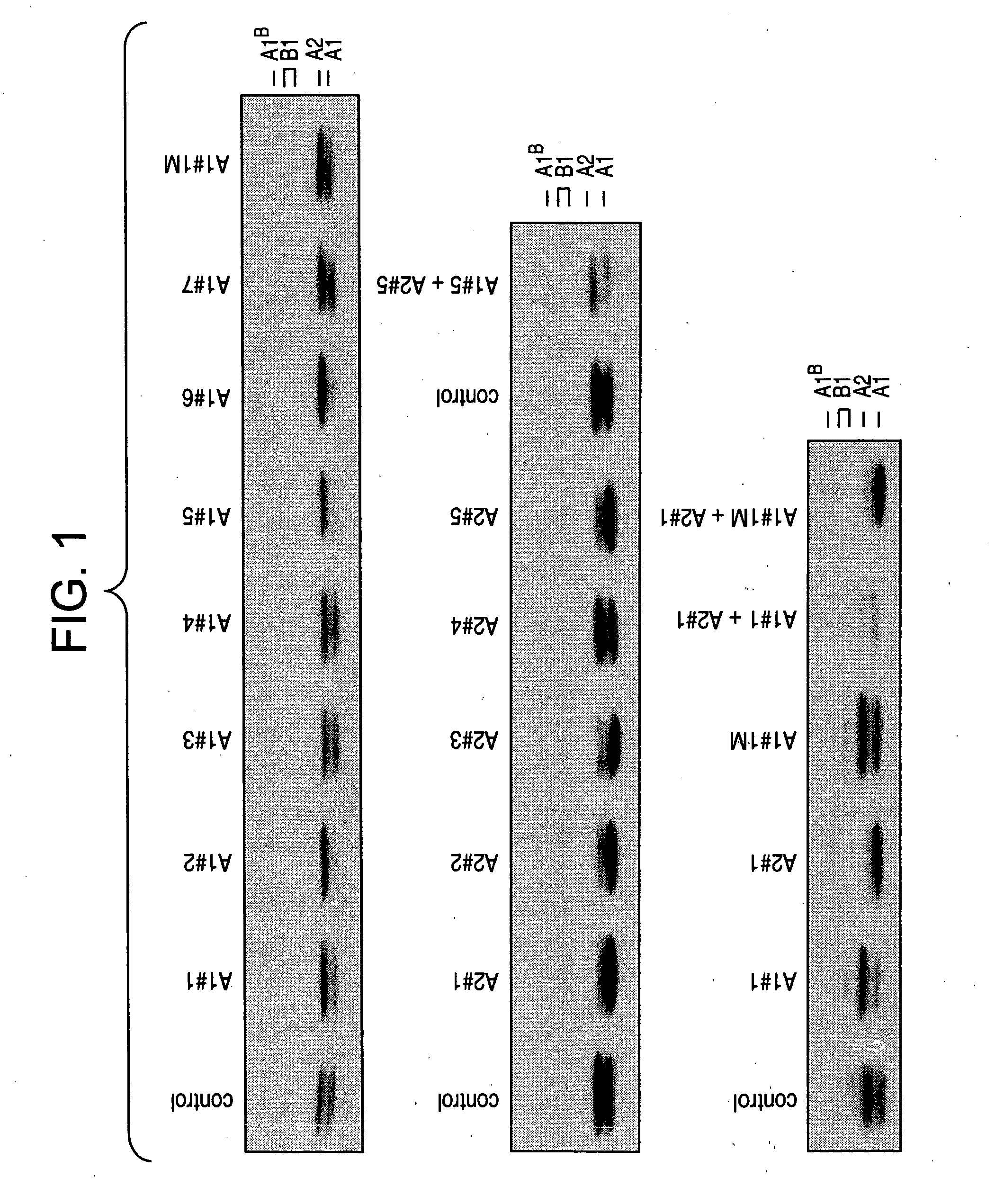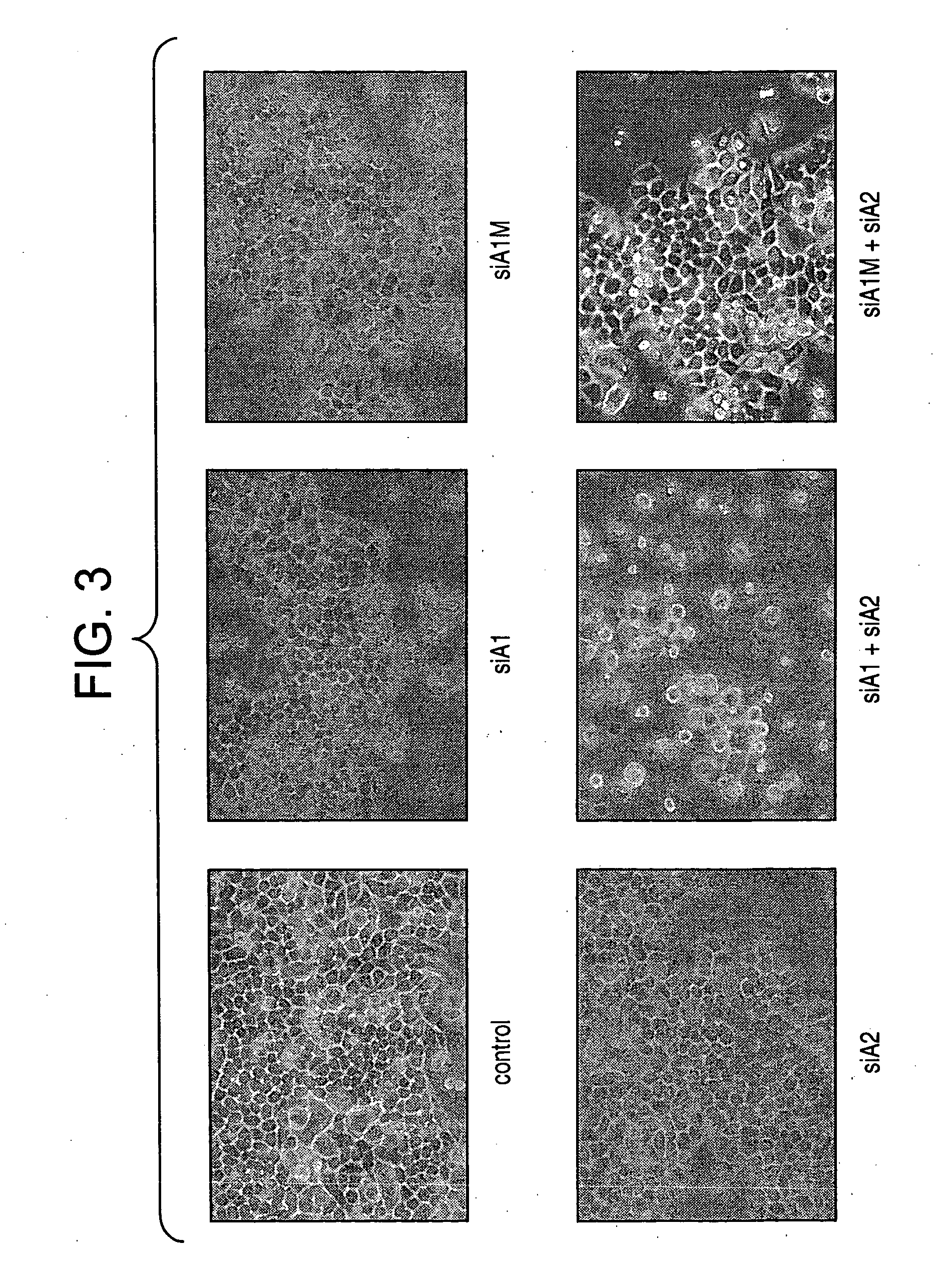Methods and compositions relating to hnRNP A1, A1B, A2, and B1 nucleic acid molecules
- Summary
- Abstract
- Description
- Claims
- Application Information
AI Technical Summary
Benefits of technology
Problems solved by technology
Method used
Image
Examples
example 1
Effects of RNAi on HeLaS3 Cell Growth and Protein hnRNP A1 and hnRNP A2 RNAi in HeLaS3 Cells
[0138] If hnRNP A1 and hnRNP A2 proteins are involved in the formation of a telomeric cap, inhibiting their expression should result in uncapping, cell growth arrest, and rapid cell death. To test this hypothesis, we needed to promote a specific reduction in the level of A1 and / or A2 proteins in human neoplastic cells. We accomplished this using siRNAs to carry out RNA interference assays.
[0139] Optimal conditions for siRNA transfection were identified using a fluorescent oligonucleotide and siRNA complementary to lamin A / C in HeLaS3 cells. We designed a variety of 19 base pair double-stranded RNAs containing a 2-nucleotide extension at the 3′ end and corresponding to portions of the A1 and A2 mRNAs. The sequences of specific siRNAs are provided below.
A1#1:5′-UGGGGAACGCUCACGGACUdTdT-3′(SEQ ID NO: 1)3′-dTdTACCCCUUGCGAGUGCCUGA-5′(SEQ ID NO: 2)A1#1M:5′-UGGGGAACCGUCACGGACUdTdT-3′(SEQ ID NO: 3...
example 2
hnRNP A1 and A2 Protein Expression in siRNA Transfected Cells
[0142] Ninety-six hours after the first transfection (as described in Example 1), total proteins were isolated and the abundance of A1 and A2 proteins was assessed by western analysis using a rabbit polyclonal antibody that binds A1, A2, and their lower abundance splice isoforms, A1B and B1 (FIG. 1).
[0143] Protein extracts from cells transfected with siRNAs targeting either hnRNP A1 or hnRNP A2 (A1-1, A1-2, A1-5 and A1-6) showed a marked reduction in the protein expression level of A1. All siRNAs against A2, with the exception of A2-4, promoted a strong decrease in A2 protein level. siRNA A1-1M did not promote a reduction in hnRNP A1. Thus, we identified several siRNAs that reduced the expression of hnRNP A1 and A2.
example 3
Cell Growth Assays in siRNA A1 and A2 Transfected Cells
[0144] To determine the effect of siRNAs that target A1 and A2 affected cell growth in human cells (FIG. 2), we transfected HeLaS3 cells with individual siRNAs, combinations of siRNAs, and control mixtures. Adherent and non-adherent cells were collected and counted 96 hours after the first transfection. We also assessed gross cellular morphology by microscopic inspection (FIG. 3). Individual siRNAs that decreased either A1 or A2 expression levels did not affect cell growth nor did they change cell morphology.
[0145] Combinations of siRNAs that promoted a reduction in the abundance of both hnRNP A1 and A2 (siRNAs A1-1 / A2-1 and A1-5 / A2-5) affected cell growth and cell morphology. In fact, the morphology of cells treated with these combinations that targeted hnRNP A1 and hnRNP A2 resembled apoptotic cells. In some experiments, the reduction in cell growth was less apparent, but the majority of the cells examined were round and loo...
PUM
| Property | Measurement | Unit |
|---|---|---|
| Fraction | aaaaa | aaaaa |
| Fraction | aaaaa | aaaaa |
| Cell death | aaaaa | aaaaa |
Abstract
Description
Claims
Application Information
 Login to View More
Login to View More - R&D
- Intellectual Property
- Life Sciences
- Materials
- Tech Scout
- Unparalleled Data Quality
- Higher Quality Content
- 60% Fewer Hallucinations
Browse by: Latest US Patents, China's latest patents, Technical Efficacy Thesaurus, Application Domain, Technology Topic, Popular Technical Reports.
© 2025 PatSnap. All rights reserved.Legal|Privacy policy|Modern Slavery Act Transparency Statement|Sitemap|About US| Contact US: help@patsnap.com



